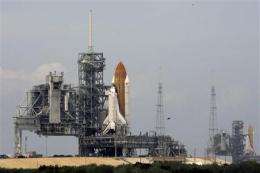Rescue shuttle at launch pad for Hubble trip

(AP) -- In what's expected to be the last time ever, both of NASA's shuttle launch pads are occupied. Atlantis is on one, primed for a flight this coming week to the Hubble Space Telescope. Endeavour sits on the other a mile away for a mission no one wants.
Endeavour is on unprecedented standby in case the seven astronauts who go up on Atlantis need to be rescued.
Atlantis and its crew are headed into space for one last repair job on the 19-year-old Hubble Space Telescope. It's a venture that was canceled five years ago because it was considered too dangerous. After a more recent delay, the launch finally is scheduled for Monday.
The risk is this: If Atlantis suffers serious damage during launch or in flight, the astronauts will not be at the international space station, where they could take refuge for weeks while awaiting a ride home. They would be stranded on their spacecraft at the Hubble, where NASA estimates they could stay alive for 25 days before running out of air.
Endeavour and four more astronauts would need to blast off on a rescue flight after NASA determined Atlantis was too damaged to fly home.
The Atlantis astronauts say there's a slim chance any rescue will be needed, and they say they would fly to Hubble even if there were no such backup plan.
Scott Altman, Atlantis' commander, said it may seem like overkill, but having a rescue ship on the pad is the right thing to do.
"It's kind of a belt-and-suspenders approach. But if you need the belt after your suspenders fail, you would be glad you had it," said Altman, a retired Navy captain and former fighter pilot.
On top of the usual launch and landing dangers, the Atlantis crew faces an estimated 1-in-229 chance that a piece of space junk or a micrometeoroid will cause catastrophic damage to their ship. Those are greater odds than for a typical shuttle flight because of Hubble's extremely high and debris-littered orbit 350 miles up.
To better their odds, Atlantis astronauts will fly to a lower, cleaner altitude as soon as they complete work on Hubble.
In addition, the astronauts will inspect their spacecraft for signs of damage before reaching Hubble and again after leaving it, just as shuttle crews always do in orbit.
NASA has had a rescue plan in case of irreparable damage ever since space shuttles resumed flying following the 2003 Columbia tragedy. Columbia was hit by fuel-tank foam during liftoff, and its left wing melted from the inside out during re-entry. The shuttle broke apart, and all seven astronauts were killed.
But there has never been a need to have the rescue ship at the launch pad, all primed and ready to go. That's because all the missions since then have been to the space station, where astronauts could camp out for two months. And all shuttle voyages after this one will go there as well.
The Hubble mission offers no such safe haven. The telescope and space station are in different orbits, and Atlantis could never get to the space station from Hubble. That's why the Hubble repair mission was canceled in 2004; NASA's boss at the time deemed it too dangerous.
A new NASA regime reversed that decision, once space shuttles were flying safely again and repair methods were developed for spacewalking astronauts. The caveat was that another shuttle be on the launch pad, all prepped and ready to fly - something never before attempted.
NASA took similar steps in 1973 during its first space station program, Skylab. But a rescue was never needed.
Once Atlantis is aloft, "if it even begins to smell" like a rescue might be needed, final preparations for Endeavour will begin, said launch director Mike Leinbach. Endeavour will be seven days from flying at the time of Atlantis' launch. Even if there is no immediate indication of launch damage, preparations will continue until Endeavour reaches the three-days-from-lifting-off mark. NASA will keep it at that three-day point until Atlantis is back on Earth.
NASA assigned a new, fresher four-man crew to the rescue mission, after the Hubble mission suffered a seven-month delay last fall. A telescope breakdown caused the postponement.
If Atlantis suffered damage too severe for repairs, the rescue craft would fly up and use a 50-foot robot arm to grab the crippled shuttle. The Atlantis astronauts would put on spacesuits and float, a few at a time, to Endeavour. Endeavour would return home with all 11 astronauts.
The toughest call, officials say, would be deciding that Atlantis indeed had serious enough damage that a rescue should be tried.
"This will be an emotional thing," Leinbach said.
Such a rescue would put four more astronauts at risk and would mean the end of Atlantis, and undoubtedly the space shuttle program, which is set to be phased out in 2010. Atlantis would be sent into the Pacific once its astronauts were aboard Endeavour.
It would rank right up there with the drama of Apollo 13, according to some NASA managers. For Leinbach, it would be the most important thing NASA has ever done, period.
Altman realizes that if pressed into service, Endeavour might not get off in time. Storms or a last-second engine shutdown could keep it grounded.
"There's no guarantee it would get there," Altman said in an interview with The Associated Press. "On the other hand, you look at how many things would have to go wrong to make it not possible to pull off. ...
"There's a scenario out there that doesn't have a happy ending, and I think we all have to come to grips with that before launch."
---
On the Net:
NASA: http://spaceflight.nasa.gov/
©2009 The Associated Press. All rights reserved. This material may not be published, broadcast, rewritten or redistributed.



















